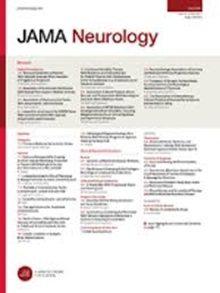Concordance Between Amyloid-PET Quantification and Real-World Visual Reads
IF 21.3
1区 医学
Q1 CLINICAL NEUROLOGY
引用次数: 0
Abstract
ImportanceWith increased payer coverage and the advent of antiamyloid therapies, clinical use of amyloid positron emission tomography (PET) is likely to increase to help guide the diagnosis and treatment of patients with cognitive impairment. However, unlike most previous research studies, in clinical practice, scan acquisition is less standardized, interpretation typically relies purely on visual reads rather than scan quantification, and patients have more frequent comorbidities, all of which might compromise test accuracy.ObjectiveTo compare visual interpretation of amyloid-PET in real-world clinical settings to scan interpretation based on central quantification, in order to assess the accuracy of clinical reads.Design, Setting, and ParticipantsThis cross-sectional quality improvement study used data from the Imaging Dementia—Evidence for Amyloid Scanning study, collected between February 2016 and January 2018 and analyzed between December 2021 and April 2023. The setting included 294 imaging facilities in the US. Medicare beneficiaries 65 years or older with cognitive decline for whom Alzheimer disease was a diagnostic consideration were recruited by dementia specialists from their clinical practices.ExposuresAmyloid-PET with [18F]florbetapir, [18F]florbetaben, or [18F]flutemetamol.Main Outcomes and MeasuresPET scans were visually interpreted as positive or negative by local radiologists or nuclear medicine physicians following approved guidelines. Independently, scans were centrally processed and quantified using the standardized Centiloid (CL) scale. We applied an a priori autopsy-based threshold of 24.4 CL to quantitatively define scan positivity.ResultsOf 18 293 participants included in the parent study, scan images were available for 10 774 (59%), of which Centiloids were successfully calculated for 10 361 (96%). Median (IQR) patient age was 75 (71-80) years; 5245 patients (51%) were female, 6500 (63%) had mild cognitive impairment, and 3861 (37%) had dementia). Participants self-reported the following races and ethnicities: 1 Alaska Native (0%), 23 American Indian (0.2%), 188 Asian (1.8%), 316 Black (3.1%), 449 Hispanic or Latino (4.3%), 8 Native Hawaiian or Other Pacific Islander (0.1%), and 9125 White (88.2%). A total of 6332 scans (61%) were visually read as positive, and 6121 (59%) were quantitatively positive. Agreement between visual reads and quantitative classification was 86.3% (95% CI, 85.7%-87.0%; Cohen κ = 0.72; 95% CI, 0.70-0.73). A total of 5519 (53%) scans were positive visually and quantitatively (V+/Q+), 3416 (33%) were negative by both (V−/Q−), 813 (8%) were V+/Q−, and 602 (6%) were V−/Q+. Female sex (female: 4581/5241 [87.4%]; male: 4354/5109 [85.2%];淀粉样蛋白- pet定量与真实世界视觉读数的一致性
随着付款人覆盖率的增加和抗淀粉样蛋白疗法的出现,淀粉样蛋白正电子发射断层扫描(PET)的临床应用可能会增加,以帮助指导认知障碍患者的诊断和治疗。然而,与大多数先前的研究不同,在临床实践中,扫描采集不太标准化,解释通常纯粹依赖于视觉读数而不是扫描量化,并且患者有更频繁的合并症,所有这些都可能影响测试的准确性。目的比较真实临床中淀粉样蛋白pet的视觉解读与基于中心量化的扫描解读,以评估临床解读的准确性。设计、环境和参与者本横断面质量改进研究使用了2016年2月至2018年1月期间收集的成像痴呆-淀粉样蛋白扫描研究证据的数据,并在2021年12月至2023年4月期间进行了分析。该研究包括美国的294个成像设施。老年痴呆症专家从他们的临床实践中招募了65岁或以上认知能力下降的老年痴呆症患者。淀粉样蛋白pet与[18F]氟倍他滨、[18F]氟倍他滨或[18F]氟替他莫的接触。当地放射科医生或核医学医生按照批准的指南,从视觉上解释主要结果和MeasuresPET扫描结果为阳性或阴性。独立地,使用标准化的Centiloid (CL)量表对扫描进行集中处理和量化。我们采用基于尸检的先验阈值24.4 CL定量定义扫描阳性。结果在本研究纳入的18 293名参与者中,有10 774名(59%)获得扫描图像,其中10 361名(96%)成功计算出了Centiloids。中位(IQR)患者年龄为75(71-80)岁;5245例(51%)为女性,6500例(63%)有轻度认知障碍,3861例(37%)有痴呆。参与者自我报告了以下种族和民族:1名阿拉斯加原住民(0%),23名美洲印第安人(0.2%),188名亚洲人(1.8%),316名黑人(3.1%),449名西班牙裔或拉丁裔(4.3%),8名夏威夷原住民或其他太平洋岛民(0.1%),9125名白人(88.2%)。6332次(61%)的扫描结果为视觉阳性,6121次(59%)的扫描结果为定量阳性。目测读数与定量分类的一致性为86.3% (95% CI, 85.7%-87.0%;Cohen κ = 0.72;95% ci, 0.70-0.73)。共有5519例(53%)扫描结果为视觉和定量阳性(V+/Q+), 3416例(33%)扫描结果均为阴性(V−/Q−),813例(8%)扫描结果为V+/Q−,602例(6%)扫描结果为V−/Q+。女性(女:4581/5241 [87.4%];男性:4354/5109 [85.2%];P =.001),白种人(白种人:7900/9125 [86.6%];非白种人:1035/1225 [84.5%];P = 0.046),使用[18F]氟替他莫和[18F]氟倍他苯([18F]氟替他莫:559/628 [89.0%];[18F]florbetaben: 2664/3032 [87.9%];[18F]florbetapir: 5712/6690 [85.4%];P <.001),与[18F]florbetapir相比,与更高的视觉-定量一致性相关。在10- 40-CL边缘阳性区域内的扫描更有可能出现不一致。结论和相关性本横断面研究发现,临床淀粉样蛋白- pet扫描的局部视觉读数与中心定量之间高度一致,支持淀粉样蛋白- pet视觉读数在实际临床实践中的有效性。
本文章由计算机程序翻译,如有差异,请以英文原文为准。
求助全文
约1分钟内获得全文
求助全文
来源期刊

JAMA neurology
CLINICAL NEUROLOGY-
CiteScore
41.90
自引率
1.70%
发文量
250
期刊介绍:
JAMA Neurology is an international peer-reviewed journal for physicians caring for people with neurologic disorders and those interested in the structure and function of the normal and diseased nervous system. The Archives of Neurology & Psychiatry began publication in 1919 and, in 1959, became 2 separate journals: Archives of Neurology and Archives of General Psychiatry. In 2013, their names changed to JAMA Neurology and JAMA Psychiatry, respectively. JAMA Neurology is a member of the JAMA Network, a consortium of peer-reviewed, general medical and specialty publications.
 求助内容:
求助内容: 应助结果提醒方式:
应助结果提醒方式:


